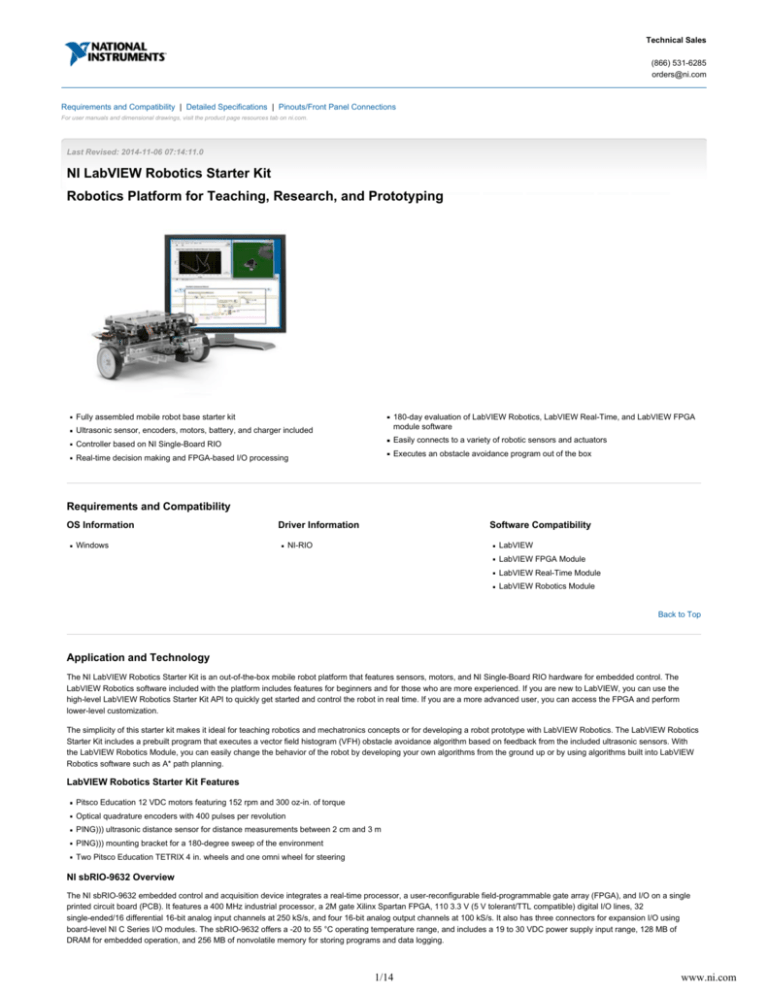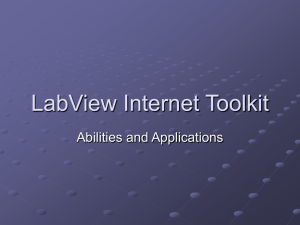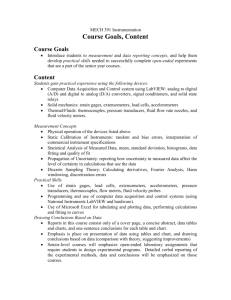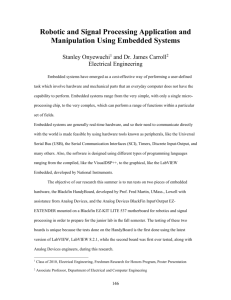
Technical Sales
(866) 531-6285
orders@ni.com
Requirements and Compatibility | Detailed Specifications | Pinouts/Front Panel Connections
For user manuals and dimensional drawings, visit the product page resources tab on ni.com.
Last Revised: 2014-11-06 07:14:11.0
NI LabVIEW Robotics Starter Kit
Robotics Platform for Teaching, Research, and Prototyping
Fully assembled mobile robot base starter kit
Ultrasonic sensor, encoders, motors, battery, and charger included
180-day evaluation of LabVIEW Robotics, LabVIEW Real-Time, and LabVIEW FPGA
module software
Controller based on NI Single-Board RIO
Easily connects to a variety of robotic sensors and actuators
Real-time decision making and FPGA-based I/O processing
Executes an obstacle avoidance program out of the box
Requirements and Compatibility
OS Information
Driver Information
Windows
Software Compatibility
NI-RIO
LabVIEW
LabVIEW FPGA Module
LabVIEW Real-Time Module
LabVIEW Robotics Module
Back to Top
Application and Technology
The NI LabVIEW Robotics Starter Kit is an out-of-the-box mobile robot platform that features sensors, motors, and NI Single-Board RIO hardware for embedded control. The
LabVIEW Robotics software included with the platform includes features for beginners and for those who are more experienced. If you are new to LabVIEW, you can use the
high-level LabVIEW Robotics Starter Kit API to quickly get started and control the robot in real time. If you are a more advanced user, you can access the FPGA and perform
lower-level customization.
The simplicity of this starter kit makes it ideal for teaching robotics and mechatronics concepts or for developing a robot prototype with LabVIEW Robotics. The LabVIEW Robotics
Starter Kit includes a prebuilt program that executes a vector field histogram (VFH) obstacle avoidance algorithm based on feedback from the included ultrasonic sensors. With
the LabVIEW Robotics Module, you can easily change the behavior of the robot by developing your own algorithms from the ground up or by using algorithms built into LabVIEW
Robotics software such as A* path planning.
LabVIEW Robotics Starter Kit Features
Pitsco Education 12 VDC motors featuring 152 rpm and 300 oz-in. of torque
Optical quadrature encoders with 400 pulses per revolution
PING))) ultrasonic distance sensor for distance measurements between 2 cm and 3 m
PING))) mounting bracket for a 180-degree sweep of the environment
Two Pitsco Education TETRIX 4 in. wheels and one omni wheel for steering
NI sbRIO-9632 Overview
The NI sbRIO-9632 embedded control and acquisition device integrates a real-time processor, a user-reconfigurable field-programmable gate array (FPGA), and I/O on a single
printed circuit board (PCB). It features a 400 MHz industrial processor, a 2M gate Xilinx Spartan FPGA, 110 3.3 V (5 V tolerant/TTL compatible) digital I/O lines, 32
single-ended/16 differential 16-bit analog input channels at 250 kS/s, and four 16-bit analog output channels at 100 kS/s. It also has three connectors for expansion I/O using
board-level NI C Series I/O modules. The sbRIO-9632 offers a -20 to 55 °C operating temperature range, and includes a 19 to 30 VDC power supply input range, 128 MB of
DRAM for embedded operation, and 256 MB of nonvolatile memory for storing programs and data logging.
1/14
www.ni.com
This device features a built-in 10/100 Mbit/s Ethernet port you can use to conduct programmatic communication over the network and host built-in Web (HTTP) and file (FTP)
servers. You also can use the RS232 serial port to control peripheral devices.
sbRIO-9632 Features
Integrated real-time controller, reconfigurable FPGA, and I/O on a single board
2M gate Xilinx Spartan FPGA
400 MHz Freescale real-time processor
128 MB DRAM, 256 MB nonvolatile storage
RS232 serial port for peripheral devices
110 3.3 V (5 V tolerant/TTL compatible) digital I/O lines
32 single-ended/16 differential 16-bit analog input channels at 250 kS/s
Four 16-bit analog output channels at 100 kS/s
10/100BASE-T Ethernet port
Low power consumption with single 19 to 30 VDC power supply input
Software Overview
You program the sbRIO-9632 device using the LabVIEW graphical development environment. The real-time processor runs the LabVIEW Real-Time Module on the Wind River
VxWorks real-time operating system (RTOS) for extreme reliability and determinism. With the addition of the LabVIEW MathScript RT Module, you can easily deploy your custom
.m files to NI real-time hardware while combining both graphical and textual syntax.
You can quickly program the onboard reconfigurable FPGA using the LabVIEW FPGA Module for high-speed control, custom I/O timing, and inline signal processing. LabVIEW
contains built-in drivers and APIs for handling data transfer between the FPGA and real-time processor.
The LabVIEW Robotics Module plugs into the LabVIEW development environment and delivers an extensive robotics library including the following:
Connectivity to robotic sensors
Foundational algorithms for intelligent operation and robust perception
Built-in physics-based environment simulator
Motion functions for making your robot or vehicle move
Real-world application examples
Forward and inverse kinematics
Libraries for protocols including I2C, SPI, PWM, and JAUS
The LabVIEW Robotics Module provides tools for developing a variety of robots, from simple and educational robots to sophisticated autonomous systems. The software offers
software architectures or templates that you can use to easily program a simple behavior-based robot, similar to the code shown in Figure 1, and for programming complex robots
with multiple subsystems executing in parallel, as shown in Figure 2.
Figure 1. A Simple Behavior-Based Robot Program
2/14
www.ni.com
Figure 2. An Advanced Robotics Program With Multiple Subsystems Executing in Parallel
The LabVIEW Robotics Module includes built-in drivers for the following sensors and cameras for the NI Single-Board RIO and NI CompactRIO embedded platforms:
Hokuyo, SICK, and Velodyne LIDAR
Sharp infrared sensors
Garmin, NavCom, and u-blox GPS
Crossbow, Microstrain, and OceanServer inertial measurement unit (IMU) [j1]
Devantech and MaxSonar sonar sensors
Devantech compass
Basler and Axis IP cameras
Analog cameras with the AF-1501 analog frame grabber from moviMED
The LabVIEW Academic Site License and the LabVIEW Academic Premium Suite include all of the required software for the LabVIEW Robotics
Starter Kit at an exceptional value for academic institutions. For more information on the academic licensing, see
ni.com/academic/purchasing.
Back to Top
Support and Services
System Assurance Programs
NI system assurance programs are designed to make it even easier for you to own an NI system. These programs include configuration and deployment services for your NI PXI,
CompactRIO, or Compact FieldPoint system. The NI Basic System Assurance Program provides a simple integration test and ensures that your system is delivered completely
assembled in one box. When you configure your system with the NI Standard System Assurance Program, you can select from available NI system driver sets and application
development environments to create customized, reorderable software configurations. Your system arrives fully assembled and tested in one box with your software preinstalled.
When you order your system with the standard program, you also receive system-specific documentation including a bill of materials, an integration test report, a recommended
maintenance plan, and frequently asked question documents. Finally, the standard program reduces the total cost of owning an NI system by providing three years of warranty
coverage and calibration service. Use the online product advisors at ni.com/advisor to find a system assurance program to meet your needs.
Technical Support
Get answers to your technical questions using the following National Instruments resources.
Support - Visit ni.com/support to access the NI KnowledgeBase, example programs, and tutorials or to contact our applications engineers who are located in NI sales
offices around the world and speak the local language.
Discussion Forums - Visit forums.ni.com for a diverse set of discussion boards on topics you care about.
Online Community - Visit community.ni.com to find, contribute, or collaborate on customer-contributed technical content with users like you.
Repair
While you may never need your hardware repaired, NI understands that unexpected events may lead to necessary repairs. NI offers repair services performed by highly trained
technicians who quickly return your device with the guarantee that it will perform to factory specifications. For more information, visit ni.com/repair.
Training and Certifications
3/14
www.ni.com
The NI training and certification program delivers the fastest, most certain route to increased proficiency and productivity using NI software and hardware. Training builds the skills
to more efficiently develop robust, maintainable applications, while certification validates your knowledge and ability.
Classroom training in cities worldwide - the most comprehensive hands-on training taught by engineers.
On-site training at your facility - an excellent option to train multiple employees at the same time.
Online instructor-led training - lower-cost, remote training if classroom or on-site courses are not possible.
Course kits - lowest-cost, self-paced training that you can use as reference guides.
Training memberships and training credits - to buy now and schedule training later.
Visit ni.com/training for more information.
Extended Warranty
NI offers options for extending the standard product warranty to meet the life-cycle requirements of your project. In addition, because NI understands that your requirements may
change, the extended warranty is flexible in length and easily renewed. For more information, visit ni.com/warranty.
OEM
NI offers design-in consulting and product integration assistance if you need NI products for OEM applications. For information about special pricing and services for OEM
customers, visit ni.com/oem.
Alliance
Our Professional Services Team is comprised of NI applications engineers, NI Consulting Services, and a worldwide National Instruments Alliance Partner program of more than
700 independent consultants and integrators. Services range from start-up assistance to turnkey system integration. Visit ni.com/alliance.
Back to Top
Detailed Specifications
Platform
405 mm x 368 mm x 150 mm (15.9'' x 14.5'' x 5.9'')
Size
3.6 kg (7.9 lb)
Weight
Battery charge time
1.7 hours
Battery charge time (with the motors turned on) *
1 hour
Battery charge time (with the motors turned off)
4 hours
*
Assuming that the robot is running the startup application (obstacle avoidance) on a fully charged battery
Ultrasonic Sensor
The Parallax PING))) ultrasonic sensor detects objects by emitting a short ultrasonic burst and then “listening” for the echo. Under the control of a host microcontroller (trigger
pulse), the sensor emits a short 40 kHz (ultrasonic) burst. This burst travels through the air at about 1130 feet per second, hits an object, and then bounces back to the sensor.
The PING))) sensor provides an output pulse to the host that terminates when the echo is detected; hence, the width of this pulse corresponds to the distance to the target.
5 VDC
Supply voltage
Supply current
30 mA typ; 35 mA max
4/14
www.ni.com
Range
2cm to 3m
Input trigger
positive TTL pulse, 2 µS min, 5 μs typ
Echo pulse
positive TTL pulse, 115 µS to 18.5 ms
Echo holdoff
750 μs from fall of trigger pulse
Burst frequency
40 kHz for 200 μs
Burst indicator
LED shows sensor activity
Delay before next measurement
200 μs
Size (H by W by D)
22mm x 46mm x 16 mm
(0.84in. x 1.8in x 0.6 in.)
DC Motors
12V
Supply voltage
300 oz-in.
Torque
152
RPM
Encoders
5V
Supply voltage
100 CPR
Cycles per revolution
400 PPR
Pulses per revolution
NI sbRIO-9632
Network
Network interface
10BaseT and 100BaseTX Ethernet
Compatibility
IEEE 802.3
10 Mbps, 100 Mbps, auto-negotiated
Communication rates
100 m/segment
Maximum cabling distance
RS-232 DTE Serial Port
Arbitrary
Baud rate support
115,200 bps
Maximum baud rate
Data bits
5, 6, 7, 8
Stop bits
1, 2
Parity
Odd, Even, Mark, Space, None
RTS/CTS, XON/XOFF, DTR/DSR, None
Flow control
Processor Speed
266 MHz
NI sbRIO-9611/9631/9641
400 MHz
NI sbRIO-9612/9632/9642 and NI sbRIO-96x2XT
Memory
Non-volatile memory
128 MB
NI sbRIO-9611/9631/9641
256 MB
NI sbRIO-9612/9632/9642 and NI sbRIO-96x2XT
System memory
64 MB
NI sbRIO-9611/9631/9641
128 MB
NI sbRIO-9612/9632/9642 and NI sbRIO-96x2XT
For information about the life span of the nonvolatile memory and about best practices for using nonvolatile memory, go to ni.com/info and enter the Info Code SSDBP.
Xilinx Spartan-3 Reconfigurable FPGA
Number of logic cells
5/14
www.ni.com
17,280
NI sbRIO-9611/9631/9641
46,080
NI sbRIO-9612/9632/9642 and NI sbRIO-96x2XT
Available embedded RAM
432 kbits
NI sbRIO-9611/9631/9641
720 kbits
NI sbRIO-9612/9632/9642 and NI sbRIO-96x2XT
3.3 V Digital I/O
110
Number of DIO channels
3 mA
Maximum tested current per channel
330 mA
Maximum total current, all lines
10 MHz
Maximum tested DIO frequency
Input logic levels
2.0 V min; 5.25 V max
Input high voltage, VIH
0 V min; 0.8 V max
Input low voltage, VIL
Output logic levels
2.7 V min; 3.3 V max
Output high voltage, VOH , sourcing 3 mA
0.07 V min; 0.54 V max
Output low voltage, VOL , sinking 3 mA
Overvoltage protection (maximum 2 pins in overvoltage)
NI sbRIO-961x/963x/964x
±20 V
at –20 to 55 °C
NI sbRIO-96x2XT
at –20 to 85 °C
±20 V
at –40 to –20 °C
±7 V
Posistor (PRG18BB330MS1RB from Murata)
760 mA
Maximum peak abnormal-condition current
Maximum hold current at 25 °C
36 mA
Maximum hold current at 70 °C
20 mA
Maximum hold current at 85 °C (NI sbRIO-96x2XT only)
3 mA
71 mA
Trip current at 25 °C
33 Ω ±20%
Resistance at 25 °C
Resistance-temperature characteristics, typical curve
6/14
www.ni.com
Analog Input
All voltages are relative to AI GND unless otherwise noted.
Number of channels
32 single-ended or 16 differential analog input channels
ADC resolution
16 bits
No missing codes guaranteed
Differential nonlinearity
Integrated nonlinearity
Refer to the AI Absolute Accuracy Tables and Formulas.
Conversion time
4.00 μs (250 kS/s)
Input coupling
DC
±10 V, ±5 V, ±1 V, ±0.2 V
Nominal input ranges
4%
Minimum overrange (for 10 V range)
Each channel must remain within ±10.4 V of common
Maximum working voltage for analog inputs (signal + common mode)
Input impedance (AI-to-AI GND)
Powered on
>10 GΩ in parallel with 100 pF
Powered off/overload
1.2 kΩ min
±100 pA
Input bias current
Crosstalk (at 100 kHz)
–65 dB
Adjacent channels
–70 dB
Non-adjacent channels
700 kHz
Small-signal bandwidth
Overvoltage protection
±24 V (one channel only)
AI channel (0 to 31)
±24 V
AISENSE
92 dB
CMRR (DC to 60 Hz)
Typical performance graphs
Settling Error Versus Time for Different Source Impedances
7/14
www.ni.com
AI <0..31> Small Signal Bandwidth
AI <0..31> CMRR
Settling time for multichannel measurements, accuracy, all ranges
±120 ppm of full-scale step
4 μs convert interval, 5.5 μs (from 50 to 85 °C)
(±8 LSB)
±30 ppm of full-scale step
8 μs convert interval
(±2 LSB)
Analog triggers
1
Number of triggers
10 bits, 1 in 1,024
Resolution
700 kHz
Bandwidth (–3 dB)
±1% of full scale
Accuracy
Scaling coefficients
Nominal Range (V) Typical Scaling Coefficient (μV/LSB)
±10
324.5
±5
162.2
±1
32.45
±0.2
6.49
AI Absolute Accuracy Tables and Formulas
The values in the following tables are based on calibrated scaling coefficients, which are stored in an onboard EEPROM. Values are valid for a two-year period between external
calibrations.
8/14
www.ni.com
Accuracy summary
Nominal
Range (V)
Absolute Accuracy at Full Scale, within 5 °C
of Last Internal Calibration (μV)
Absolute Accuracy at Full
Scale, –20 to 55 °C (mV)
(XT Devices Only) Absolute Accuracy at
Full Scale, –40 to 85 °C (mV)
Random
Noise, σ (μV
)
rms
Sensitivity
1
(μV)
±10
7,820
36.6
52.0
244
97.6
±5
3,990
18.6
26.4
122
48.8
±1
870
4.27
6.07
30
12.0
±0.2
244
1.37
1.96
16
5.2
Accuracy details
Nominal
Range (V)
Residual Gain Error (ppm of
Reading)
Gain Tempco
(ppm/°C)
Reference
Tempco
Residual Offset Error (ppm of
Range)
Offset Tempco (ppm of
Range/°C)
INL Error (ppm of
Range)
±10
94
23
5
20
49
76
±5
104
23
5
20
50
76
±1
114
23
5
25
62
76
±0.2
154
23
5
40
118
76
Absolute accuracy formulas
AbsoluteAccuracy = Reading · GainError + Range · OffsetError + NoiseUncertainty
GainError = ResidualGainError + GainTempco · TempChangeFromLastInternalCal + ReferenceTempco · TempChangeFromLastExternalCal
OffsetError = ResidualOffsetError + OffsetTempco · TempChangeFromLastInternalCal + INL_Error
NoiseUncertainty = (RandomNoise · 3) /
for a coverage factor of 3σ and averaging 100 points.
Absolute accuracy at full scale on the analog input channels is determined using the following assumptions:
TempChangeFromLastExternalCal = 45 °C
TempChangeFromLastInternalCal = 5 °C
NumberOfReadings = 100
CoverageFactor = 3 σ
For example, on the 10 V range, the absolute accuracy at full scale is as follows:
GainError = 94 ppm + 23 ppm · 5 + 5 ppm · 45 GainError = 434 ppm
OffsetError = 20 ppm + 49 ppm · 5 + 76 ppm OffsetError = 341 ppm
NoiseUncertainty = (244 μV · 3) /
Noise Uncertainty = 73.2 μV
AbsoluteAccuracy = 10 V · 434 ppm + 10 V · 341 ppm + 73.2 μV
AbsoluteAccuracy = 7,823 μV (rounds to 7,820 μV)
To determine the absolute accuracy over the full operating temperature range, let:
TempChangeFromLastInternalCal = 45 °C
Analog Output (NI sbRIO-963x/9632XT and NI sbRIO-964x/9642XT Only)
4 analog output channels
Number of channels
16 bits
DAC resolution
String
Type of DAC
±10 V
Output range
Operating voltage
±10.7 V
Nominal
±10.3 V
Minimum
±11 V
Maximum
Current drive
±3 mA per channel
Output impedance
0.1 Ω
9/14
www.ni.com
Accuracy
Measurement Conditions
Percent of Reading (Gain Error) Percent of Range 2 (Offset Error)
Calibrated, max (–40 to 85 °C)
0.35%
0.75%
Calibrated, typ (25 °C, ±5 °C)
0.01%
0.1%
Uncalibrated, max (–40 to 85 °C) 2.2%
1.7%
Uncalibrated, typ (25 °C, ±5 °C)
0.25%
0.3%
Stability
80 μV/°C
Offset drift
6 ppm/°C
Gain drift
Protection
±25 V at 25 °C
Overvoltage
Indefinitely
Short-circuit
0V
Power-on voltage
Note All analog outputs are unpowered until a value is written to an analog output.
Update time
One channel in use
3 μs
Two channels in use
5 μs
Three channels in use
7.5 μs
9.5 μs
Four channels in use
Noise
Updating at 100 kS/s
600 μVrms
Not updating
260 μVrms
4 V/μs
Slew rate
76 dB
Crosstalk
Settling time (100 pF load, to 1 LSB)
20 μs
FS step
10 μs
3 V step
8 μs
0.1 V step
Glitch energy (256 steps, worst case)
2 mV for 2 μs
Capacitive drive
1,500 pF min
16 bits
Monotonicity
–1 to 2 LSBs max
Differential nonlinearity
16 LSBs max
Integrated nonlinearity (endpoint)
Power Limits
Caution Exceeding the power limits may cause unpredictable behavior by the device.
+5 V ±5%, 2 A max (shared with C Series modules)
5 V pins (P2, P3, P4, P5)
Power Requirements
The NI sbRIO device requires a power supply connected to connector J3. Refer to the Powering the NI sbRIO Device section in the User Guide for information about connecting
the power supply.
19–30 VDC 6
Power supply voltage range
1.8 A
Power supply current limit
2 A non-replaceable
Power connector internal fuse
Total power requirement = Pint + PDIO + P5V + P CSer , where:
Pint is the consumption by sbRIO internal operation, including integrated I/O
P DIO is the consumption by the 3.3 V DIO
10/14
www.ni.com
P5V is the consumption by the 5 V voltage output
PCSer is the consumption by installed board-only C Series modules.
Note You must add 20% to the calculated or measured total power requirement to account for transient and startup conditions.
Maximum Pint
7.50 W
NI sbRIO-961x/9612XT
7.75 W
NI sbRIO-963x/9632XT
8.00 W
NI sbRIO-964x/9642XT
1.28 W
Maximum PDIO
PDIO = Total DIO Current × 3.3 V/0.85
11.1 W
Maximum P5V
P5V = Total 5 V Output Current × 5 V/0.9
3.3 W; each installed C Series module consumes up to 1.1 W.
Maximum PCSer
Example power requirement calculations:
For an NI sbRIO-9642/9642XT with three installed board-only C Series modules, 20 mA total current through the 3.3 V DIO pins, and 1 A of current through the 5 V output,
calculate the total power requirement as follows:
Pint = 8.00 W
PCSer = 3.30 W
PDIO = 0.08 W
P5V = 5.55 W
Adding 20% for transient conditions, 16.93 W × 1.2 = 20.32 W
Total power requirement = 20.32 W
For an sbRIO-9612/9612XT with one installed board-only C Series module, 330 mA total current through the 3.3 V DIO pins, and no 5 V output used, calculate the total power
requirement as follows:
Pint = 7.50 W
PCSer = 1.10 W
PDIO = 1.28 W
P5V = 0.00 W
Adding 20% for transient conditions, 9.88 W × 1.2 = 11.86 W
Total power requirement = 11.86 W
3 V lithium coin cell, BR2032 (–40 to 85 °C)
Backup battery
Safety Voltages
Connect only voltages that are within this limit.
35 VDC max, Measurement Category I
V terminal to C terminal
Measurement Category I is for measurements performed on circuits not directly connected to the electrical distribution system referred to as MAINS 7 voltage. This category is for
measurements of voltages from specially protected secondary circuits. Such voltage measurements include signal levels, special hardware, limited-energy parts of hardware,
circuits powered by regulated low-voltage sources, and electronics.
Caution Do not connect the system to signals or use for measurements within Measurement Categories II, III, or IV.
Environmental Management
National Instruments is committed to designing and manufacturing products in an environmentally responsible manner. NI recognizes that eliminating certain hazardous
substances from our products is beneficial not only to the environment but also to NI customers.
For additional environmental information, refer to the NI and the Environment Web page at ni.com/environment. This page contains the environmental regulations and directives
with which NI complies, as well as other environmental information not included in this document.
Waste Electrical and Electronic Equipment (WEEE)
EU Customers At the end of the product life cycle, all products must be sent to a WEEE recycling center. For more information about WEEE recycling centers, National
Instruments WEEE initiatives, and compliance with WEEE Directive 2002/96/EC on Waste Electrical and Electronic Equipment, visit ni.com/environment/weee.htm.
Battery Replacement and Disposal
Battery Directive This device contains a long-life coin cell battery. If you need to replace it, use the Return Material Authorization (RMA) process or contact an authorized
National Instruments service representative. For more information about compliance with the EU Battery Directive 2006/66/EC about Batteries and Accumulators and Waste
Batteries and Accumulators, visit ni.com/environment/batterydirective.
11/14
www.ni.com
Environmental
The NI sbRIO-96xx/96x2XT is intended for indoor use only.
Ambient temperature in enclosure (IEC 60068-2-1, IEC 60068-2-2)
–20 to 55 °C
NI sbRIO-961x/963x/964x
–40 to 85 °C
NI sbRIO-96x2XT
–40 to 85 °C
Storage temperature (IEC 60068-2-1, IEC 60068-2-2)
Operating humidity (IEC 60068-2-56)
10 to 90% RH, noncondensing
Storage humidity (IEC 60068-2-56)
5 to 95% RH, noncondensing
2,000 m
Maximum altitude
2
Pollution Degree (IEC 60664)
Physical Characteristics
Torque for screw terminals on J3
0.5 to 0.6 N · m (4.4 to 5.3 lb · in.)
Weight
269.3 g (9.5 oz)
Block Diagram
1
Sensitivity is the smallest voltage change that can be detected. It is a function of noise.
2
Range equals ±10.7 V
3
Setup time is the amount of time input signals must be stable before you can read from the module.
4
Transfer time is the maximum time FPGA Device I/O functions take to read data from the module.
5
Refer to the Increasing Current Drive section in the User Guide for information about installing heat sinks.
6
The NI sbRIO device is 1–2% more efficient with a 19 V supply than with a 30 V supply.
7
MAINS is defined as a hazardous live electrical supply system that powers hardware. Suitably rated measuring circuits may be connected to the MAINS for measuring purposes.
Back to Top
12/14
www.ni.com
Pinouts/Front Panel Connections
LabVIEW Robotics Starter Kit (Block Diagram)
13/14
www.ni.com
NI sbRIO-961x/9612XT/963x/9632XT and NI sbRIO-964x/9642XT
Back to Top
©2011 National Instruments. All rights reserved. CompactRIO, FieldPoint, LabVIEW, National Instruments, National Instruments Alliance Partner, NI, and ni.com are trademarks of National Instruments. TETRIX by
Pitsco is a trademark of Pitsco, Inc. Other product and company names listed are trademarks or trade names of their respective companies. A National Instruments Alliance Partner is a business entity independent
from National Instruments and has no agency, partnership, or joint-venture relationship with National Instruments.
My Profile | RSS | Privacy | Legal | Contact NI © 2014 National Instruments Corporation. All rights reserved.
14/14
www.ni.com







